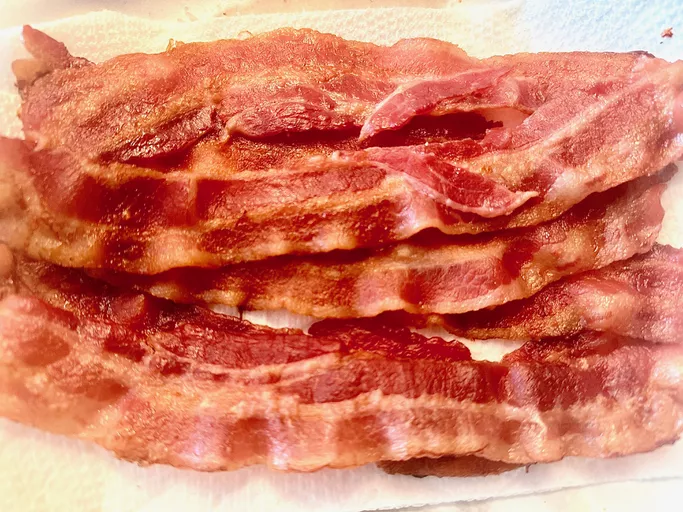What is Crispy Oven-Baked Bacon?
The Science Behind Crunchy Texture
- The allure of crispy oven-baked bacon lies in its perfectly balanced texture, which combines a satisfying crunch with a savory flavor.
- Crispy oven-baked bacon is a culinary delight that has gained popularity in recent years due to its ease of preparation and the ability to achieve that perfect crispy texture without deep-frying it.
- The science behind the crunchy texture of crispy oven-baked bacon can be attributed to several factors, including the Maillard reaction, the role of fat, and the impact of cooking temperature and time.
Maillard Reaction
- The Maillard reaction is a chemical reaction between amino acids and reducing sugars that occurs when food is cooked, leading to the formation of new flavor compounds and browning.
- This reaction is responsible for the development of the characteristic golden-brown color and crispy texture of baked bacon.
Role of Fat
- Fat plays a crucial role in achieving the perfect crispiness of oven-baked bacon.
- The fatty acids in the meat contribute to its tenderness and flavor, while the rendered fat helps to create a crunchy exterior.
- However, too much fat can lead to greasiness, so it’s essential to balance the amount of fat in the meat for optimal results.
Cooking Temperature and Time
- The cooking temperature and time have a significant impact on the texture and flavor of oven-baked bacon.
- Higher temperatures (around 400°F/200°C) help to crisp the bacon faster, while lower temperatures (around 300°F/150°C) promote even browning and a more tender texture.
- The cooking time will also affect the level of crispiness, with shorter times resulting in chewier textures and longer times leading to crisper results.
Optimizing Crispiness
To achieve the perfect crispiness, it’s essential to follow some key steps:
- Bake the bacon at a moderate temperature (around 375°F/190°C) for an extended period of time.
- Line the baking sheet with parchment paper or aluminum foil to prevent sticking and make cleanup easier.
- Pat dry the bacon before cooking to remove excess moisture, which can lead to greasiness.
In conclusion, crispy oven-baked bacon is a culinary delight that requires the perfect balance of texture and flavor.
- The science behind its crunchy texture involves the Maillard reaction, the role of fat, and the impact of cooking temperature and time.
- By understanding these factors and following some key steps to optimize crispiness, you can create the perfect crispy oven-baked bacon in the comfort of your own home.
Crunchy texture in food is achieved through the Maillard reaction, a chemical reaction between amino acids and reducing sugars that occurs when food is cooked, leading to the formation of new flavor compounds and browning. This reaction is responsible for the crispy texture of oven baked bacon.
Crispy Oven-Baked Bacon is a cooking method that involves baking bacon in the oven to achieve a crispy texture, which is often associated with deep-frying.
The key to achieving this crispy texture lies in the Maillard reaction, a chemical reaction between amino acids and reducing sugars that occurs when food is cooked. This reaction leads to the formation of new flavor compounds and browning, resulting in a crunchy exterior and a tender interior.
When bacon is baked in the oven, the high heat breaks down the proteins and fats on the surface, causing them to caramelize and crisp up. This process is accelerated by the Maillard reaction, which occurs between the amino acids and reducing sugars present in the bacon.
The Maillard reaction is responsible for the development of complex flavor compounds, such as pyrazines and furans, which contribute to the distinctive taste and aroma of crispy oven-baked bacon. These compounds are formed through a series of chemical reactions involving the breakdown of amino acids and reducing sugars.
In addition to its rich flavor, crispy oven-baked bacon is also prized for its satisfying crunch, which makes it a popular topping for salads, sandwiches, and other dishes. The crunchy texture provides a pleasant contrast to the softness of many foods, making it a versatile ingredient in both sweet and savory recipes.
Overall, Crispy Oven-Baked Bacon is a delicious and satisfying ingredient that offers a unique combination of flavors and textures. Its crispy exterior and tender interior make it a popular choice for cooks looking to add depth and variety to their dishes.
By controlling the cooking temperature, time, and air circulation around the bacon, home cooks can achieve a perfectly crispy texture every time, making Crispy Oven-Baked Bacon a staple in many kitchens.
Benefits of Cooking Bacon in the Oven
Less Messy and Healthier Option
Cooking bacon in the oven can be a game-changer for anyone who loves this savory ingredient but hates the mess and hassle that comes with pan-frying it.
Here are some benefits of cooking bacon in the oven:
- Less Messy
- No more splatters and spills to clean up, making this method a great option for those who want to minimize kitchen chaos.
- No risk of burning or overcooking the bacon, as you can set the temperature and cooking time to perfection.
One of the most significant advantages of oven-baked bacon is that it’s a healthier option compared to pan-frying. Here’s why:
- No added oils or fats are necessary when cooking in the oven, reducing calorie intake and saturated fat consumption.
- You can cook multiple slices of bacon at once without overcrowding, allowing for even cooking and better browning.
Additionally, oven-baked bacon is often less greasy than pan-fried, making it a great option for sandwiches, salads, or as a topping for breakfast dishes.
To achieve crispy oven-baked bacon, simply line a baking sheet with foil or parchment paper and lay the bacon slices out in a single layer. Bake at 400°F (200°C) for about 15-20 minutes or until crispy, flipping halfway through. You can also use the convection setting for faster cooking time.
Remember to keep an eye on your bacon as it cooks, as oven temperatures and times may vary depending on the thickness of the slices and personal preference for crispiness. Enjoy your perfectly cooked, crispy oven-baked bacon!
Cooking bacon in the oven reduces the splatter and mess associated with panfrying, making it a cleaner option. Additionally, oven baked bacon cooks at a lower temperature than pan fried bacon, resulting in less acrylamide formation, a potential carcinogen that can be created during high heat cooking.
Cooking bacon in the oven offers numerous benefits over traditional pan-frying methods, making it a popular choice among cooks. One of the main advantages is the reduced mess and splatter associated with cooking bacon at high heat in a pan.
When panfrying bacon, hot grease can splatter and spread quickly, making a big mess and creating a hassle for cleaning up. In contrast, oven-baked bacon cooks gently in the oven, eliminating the risk of splatter and mess.
Another significant benefit of cooking bacon in the oven is the reduced formation of acrylamide, a potential carcinogen that can be created during high-heat cooking. Acrylamide is a chemical compound that forms when starchy foods are cooked at high temperatures, and it has been linked to an increased risk of certain cancers.
Oven-baked bacon cooks at a lower temperature than panfried bacon, typically between 400°F to 425°F (200°C to 220°C), which results in less acrylamide formation. This is because the lower heat reduces the rate at which starchy molecules break down and form acrylamide.
In addition to these benefits, cooking bacon in the oven also offers more even cooking and a crisper texture than panfried bacon. By laying the bacon slices on a baking sheet lined with parchment paper or foil, you can achieve a consistent, crispy texture throughout each piece of bacon.
Furthermore, oven-baked bacon is often easier to cook than panfried bacon. Simply line a baking sheet with parchment paper or foil, lay out the bacon slices, and bake in the preheated oven for 15-20 minutes, depending on your desired level of crispiness.
Overall, cooking bacon in the oven offers numerous benefits over traditional pan-frying methods. With its reduced mess and splatter, lower acrylamide formation, more even cooking, and crisper texture, oven-baked bacon is a great choice for those looking to elevate their breakfast or snack game.
Whether you’re a seasoned cook or just starting out in the kitchen, cooking bacon in the oven is definitely worth trying. With its many benefits and ease of use, it’s an excellent option for anyone looking to create delicious, crispy bacon at home.
Tips for Achieving Perfect Oven-Baked Bacon
Linings and Temperature Control
To achieve perfect oven-baked bacon, it’s essential to pay attention to a few key factors: linings, temperature control, and cooking time.
Choosing the Right Lining:
- A baking sheet lined with aluminum foil can help make cleanup easier, but some people find that it interferes with the bacon’s texture. If you prefer to use foil, look for heavy-duty or parchment-lined options.
- Alternatively, use a silicone mat or a piece of parchment paper directly on the baking sheet. These linings can help prevent the bacon from sticking and make it easier to remove when cooked.
Temperature Control:
- Preheat your oven to its lowest temperature setting (usually around 200-250°F or 90-120°C). This is crucial for slow-cooking the bacon and preventing it from burning.
- For a thicker cut of bacon, you may want to use a higher temperature. For example, 300-350°F (150-180°C) can help achieve a crisper texture. However, this can increase the risk of burning.
Cooking Time and Shaking:
- Place the bacon strips on the prepared baking sheet in a single layer, leaving some space between each strip to allow for even cooking.
- Cook the bacon in the preheated oven for about 15-20 minutes or until it reaches your desired level of crispiness. You can check on it after 10 minutes and shake the baking sheet to redistribute the strips and promote even cooking.
Additional Tips:
- For a more evenly cooked texture, try folding the bacon in half or using a thicker cut. This can help prevent it from curling up during cooking.
- To enhance the flavor of your oven-baked bacon, try sprinkling some brown sugar, smoked paprika, or other seasonings on top before baking.
Remember to keep an eye on the bacon while it’s cooking and adjust the temperature or cooking time as needed. With practice and patience, you can achieve perfectly crispy oven-baked bacon that’s perfect for salads, sandwiches, or snacking straight from the oven!
To achieve perfect ovenbaked bacon, line the baking sheet with foil to make cleanup easy. Cook the bacon at 400°F (200°C) to ensure even browning and crispy texture.
To achieve perfect oven-baked bacon, it’s essential to start with a clean slate – literally. Line the baking sheet with foil to make cleanup easy and prevent the bacon from sticking to the metal.
The next crucial step is to set your oven temperature correctly. Cooking the bacon at 400°F (200°C) will ensure even browning and crispy texture throughout. This temperature also helps to cook the bacon quickly, reducing the risk of overcooking or undercooking certain areas.
Another important consideration when baking bacon in the oven is to use a single layer on the prepared baking sheet. This allows for maximum surface area exposure to heat, which promotes even cooking and crisping. By not overcrowding the baking sheet, you can also prevent the transfer of moisture from one piece of bacon to another, which can lead to steaming rather than crisping.
It’s also worth noting that different types of bacon may require slightly varying cooking times due to their thickness or fat content. To achieve perfectly cooked oven-baked bacon, monitor the strips closely and remove them from the oven once they reach your desired level of crispiness. This can range anywhere from 10 to 20 minutes, depending on individual preferences.
Some people prefer their oven-baked bacon extra crispy, while others like it chewy. To achieve a crisper texture, try baking the strips for a longer period or at a higher temperature – but be cautious not to overcook them. Conversely, if you’re aiming for a chewier texture, bake the strips for a shorter time or at a lower temperature.
Lastly, when it comes to seasonings and flavorings, feel free to get creative with your oven-baked bacon! Experiment with herbs, spices, sugars, or other ingredients to develop unique flavor profiles. Some popular options include brown sugar, smoked paprika, garlic powder, or even cinnamon. The possibilities are endless!
In conclusion, achieving perfect oven-baked bacon requires attention to detail and a willingness to experiment. By mastering these tips – from using foil-lined baking sheets to experimenting with different seasonings – you’ll be well on your way to creating the crispiest, most delicious bacon your taste buds have ever encountered.
- Best Clay Alternatives for 2025 - April 22, 2025
- Best Leadfeeder Alternatives for 2025 - April 22, 2025
- Best Snov.io Alternatives for 2025 - April 21, 2025














